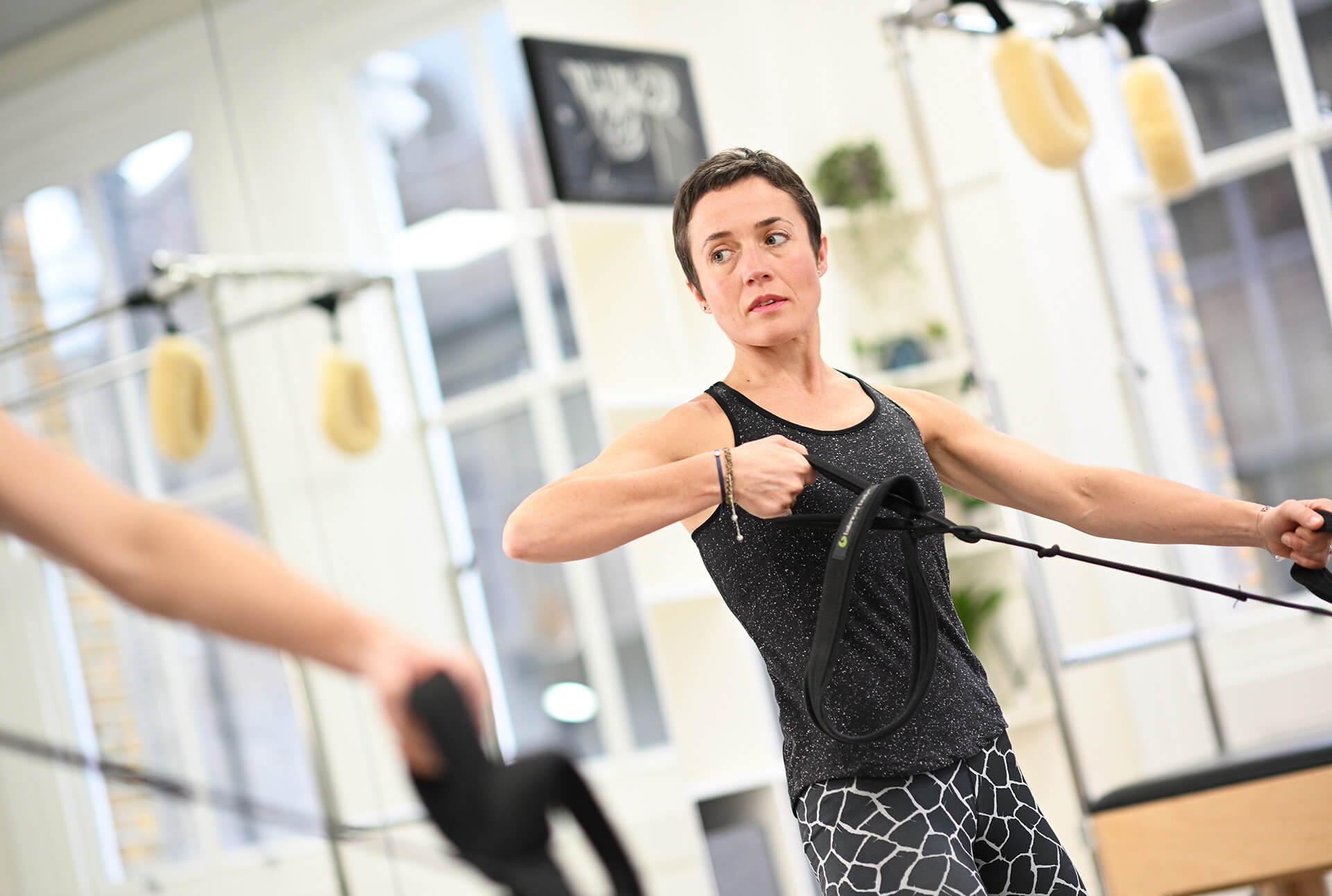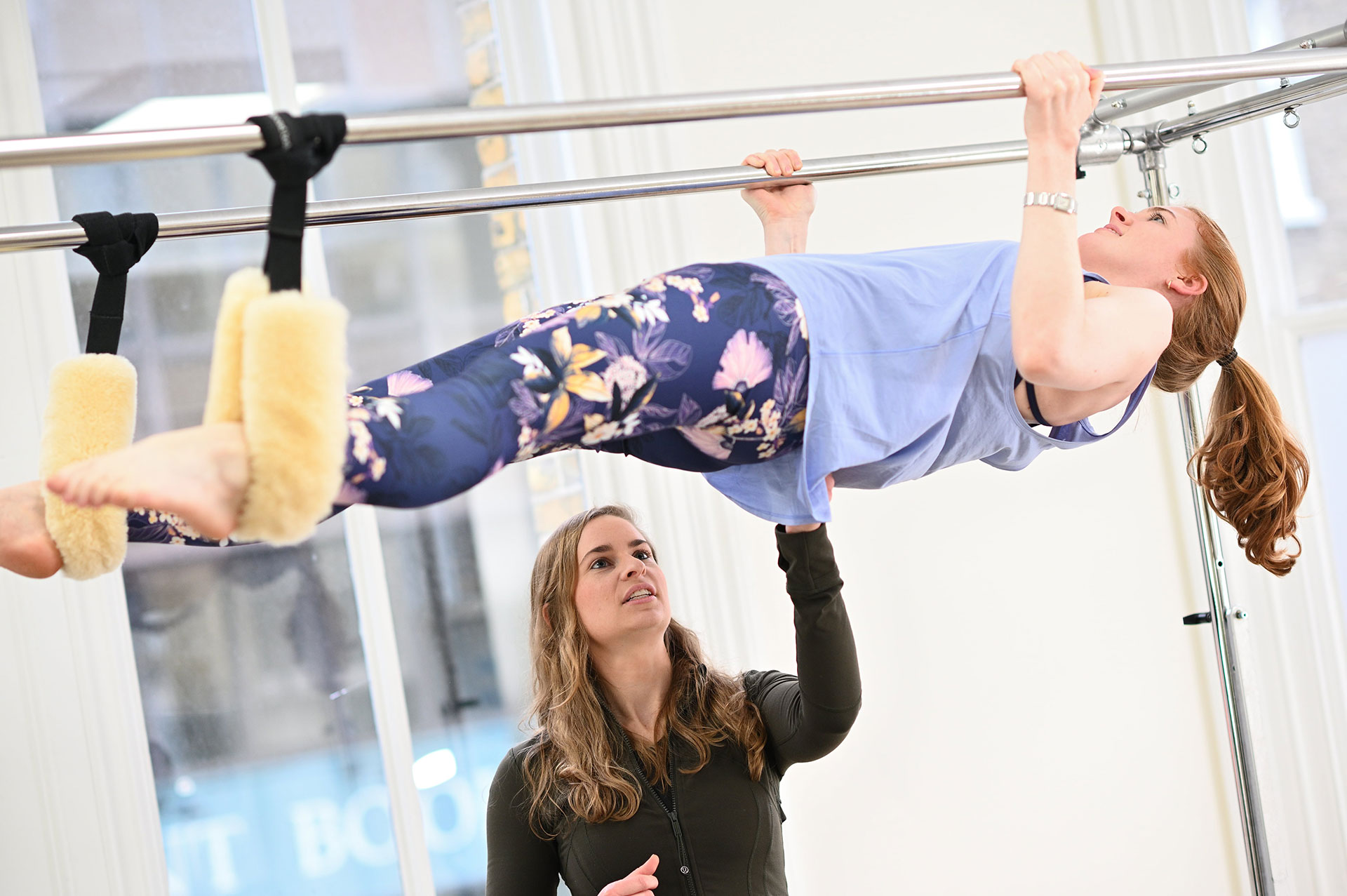Key Contributor: Isabelle Bay, Chartered Physiotherapist
Osteoporosis is a major worldwide health issue. In the UK, 1 in 3 women and 1 in 5 men over the age of 50 will experience an osteoporotic break of a bone. These breaks can be a major cause of pain and disability, particularly as we get older. So, is Pilates good for Osteoporosis? The simple answer is yes – while it hasn’t been shown conclusively, that Pilates can impact bone density, it has been shown to be an effective form of exercise at reducing the risk of falls and Osteoporotic breaks and providing a safe form of exercise that helps to improve the overall wellbeing and quality of life of those with Osteoporosis.
In this article, we’ll be discussing:
- What Osteoporosis and Osteopenia are
- The common causes and symptoms
- How to prevent and manage Osteoporosis
- Pilates and Osteoporosis
- Exercises to help Osteoporosis
- Exercises to avoid with Osteoporosis
Quick Summary: Is Pilates good for Osteoporosis?
- Over 3 million people in the UK are affected by Osteoporosis, a condition that makes bones more prone to fractures, particularly in the hip, spine, and wrist. Osteopenia, a precursor to Osteoporosis, indicates lower-than-normal bone density and may not always progress to Osteoporosis if managed with lifestyle changes like diet, exercise, or medication.
- Osteoporosis risk is influenced by factors like sex, age, race, lifestyle habits, certain medications, and medical conditions. Early signs often go unnoticed, but symptoms such as height loss, stooped posture, or unexpected fractures may indicate weakened bones. A DEXA scan helps assess bone density, though interpreting results requires considering multiple risk factors for a complete understanding of fracture risk.
- For those with Osteoporosis, managing the condition can involve medication, a nutrient-rich diet, and appropriate exercise—especially clinical Pilates, which strengthens posture-supporting muscles and helps prevent fractures. However, certain movements, like forward spinal bends, might need to be avoided, so it’s essential to work with a trained instructor to ensure exercises are safe and tailored to individual needs.
What is Osteoporosis?
Osteoporosis is a health condition where bones lose strength, making them more likely to break. The reduction in bone density develops over time and most people won’t know they have Osteoporosis until they break a bone after an impact or fall. Osteoporosis can affect any bone, but it most commonly affects the spine, hips and wrists. The condition itself is not painful, but breaking a bone is and can cause long-term effects such as chronic pain and reduced mobility.
What is Osteopenia?
Osteopenia is the stage before Osteoporosis where the bone density is lower than what it should be but not low enough to be classed as Osteoporosis. Osteopenia may not necessarily lead to Osteoporosis and things like diet, exercise and lifestyle changes can reduce the risk of developing it.
Is Pilates good for Osteopenia and Osteoporosis?
Pilates is a safe and effective exercise-management tool for those with or at risk for, Osteopenia and Osteoporosis. In particular, Pilates can help those with fractures rehabilitate, reducing pain and improving strength and mobility. Pilates is also an excellent way to reduce risk of falls, by improving stability, balance and coordination. Performing strength work in Pilates also helps strengthen the muscles around the joints, protecting them from bumps and falls. Those with Osteoporosis or Osteopenia of the spine benefit from exercises that improve spinal posture, reducing hunching of the spine and reducing load on the vertebrae. Physio-led Pilates ensures that if you have fractures, or are at risk of fractures, you are being guided through an exercise program that is safe and effective for you and avoiding any movements that may increase your risk of fracture or harm.
What do our experts say?
“Pilates is an excellent choice of exercise for those living with osteoporosis. Pilates can strengthen muscles in a safe, controlled manner, with a large proportion of the repertoire including weight bearing exercise which helps to build bone density. Dynamic stability is a huge focus in Pilates which helps to improve balance and coordination, in turn preventing falls and their subsequent consequences such as fractures. Furthermore, Pilates emphasises the importance of posture and alignment which is critical for those living with osteoporosis in avoiding placing further stress on the spine. Therefore, if you are living with osteoporosis commencing a journey with Pilates can enhance your health significantly.”
4 Pilates exercises for Osteoporosis
Below are four simple Pilates exercises which you can do at home, in your own time and space, to help you manage your osteoporosis. They are all safe, provided you are pain-free and mobile. We would advise you to aim to do these at least three times a week to feel the difference.
1. Standing Footwork
This exercise is great for challenging your balance, coordination and strengthening those important anti-gravity muscles;
- Firstly stand tall.
- Push your hips back into a small squat and then lift your heels and press the ball of the foot into the floor.
- Straighten the knees and then lower the heels.
- Repeat x 15
2. Scooter
This exercise is a fantastic exercise which helps to challenge your balance and strength through the spine and hips.
- Bend the knee of the standing leg slightly and lean forward a little
- Maintain a neutral spine and engage the core
- Exhale to press the leg that isn’t bent away using the inside leg, straightening that leg and inhale as you control it back in.
3. Press ups
Press ups help to strengthen the triceps which in turn reduces the risk of wrist fractures.
- Come into all fours with your hands under the shoulders and the knees under the hips.
- Lean forward as you bend the elbows along the line of your body so that you feel your upper arms working as your chest lowers and then lifts again.
- Aim to maintain your spine in the same posture throughout.
- Repeat x 15
4. Dart
- This move works the strength down the back of your body to keep your spine upright, protect the spinal bones and help with balance.
- Start by lying on your front. If it’s comfortable, rest your forehead on a small, folded towel. Arms are by your side.
- Now, imagine that your body is being stretched as tall as possible from the crown of your head down to your tailbone.
- Roll the shoulders back to open up the collar bones and hover the hands.
- Next, allow the head and chest up to come off the floor – this will work the upper back. Remember: you shouldn’t feel any pain or strain in the lower back.
- Slowly lower back down
- Repeat x 10
Pilates exercises to avoid for Osteoporosis
If you have osteoporosis there are certain movements which you need to avoid during exercise, particularly forward bends (flexion) of the spine or rotation when bending forwards to reduce the risk of harming your vertebrae.
Traditional Pilates sessions that have not been adapted for osteoporosis can include these forward bending movements which means you need to ensure your instructor knows about your diagnosis and is trained in teaching and modifying movements for it.
As already mentioned, you should mainly focus on working on your strength and balance. You should consult with an exercise specialist, like a specialist osteoporosis physiotherapist or clinical Pilates Instructor for individual advice.
More about Osteoporosis
What are the causes of Osteoporosis?
There are a number of factors that can affect the development of Osteoporosis. Some of these risk factors directly affect your bone density, and some affect how strong your bones are or the risk of them breaking in other ways. Understanding these risk factors can help identify where you can make changes, both to avoid developing Osteoporosis or even after diagnosis.
The following are known risk factors in developing Osteoporosis:
- Genetics: your genetics can predict the size and strength of your bones
- Age: from your late 30s, bone density starts to decrease
- Sex: Osteoporosis affects women more than men, especially after menopause where bone density declines more rapidly
- Fracture history: evidence shows, breaking one bone increases the chance of breaks in the future
- Body weight: lower body weight usually means you have less bone tissues and as you age, having lower body weight means there’s less padded tissue to protect you if you fall
- Smoking: smoke slows the cells that build bones in your body
- Alcohol: excessive alcohol consumption affects the cells that build bone and can also increase risk of falling
- Balance: reduced balance and coordination can increase the chances of tripping and falling
- Medication & Medical History: certain medications can affect bone strength as can certain conditions such as rheumatoid arthritis and thyroid conditions.
Related reading: Pilates for menopause – is it beneficial?
You can find out if you’re at risk of Osteoporosis by completing the Royal Osteoporosis Society’s online test.
What are the symptoms of Osteoporosis?
Although there are no real symptoms in the early stages of bone loss, once they become weak certain symptoms of osteoporsis to look out for might include:
- Loss of height over time
- A stooped posture
- A bone that breaks much more easily than expected
- Back pain, caused by a fractured or collapsed vertebra
Finding out more about your risk factors for Osteoporosis as outlined above can help you identify if you could be prone to it before you break a bone. Crucially, you may notice something you can change to protect your bones.
How do you diagnose Osteoporosis?
Many people being investigated for osteoporosis will have their bone density assessed with a DEXA scan. This will give you a score for each area measured, this is usually the hip and spine. It can be confusing to understand the results of this test and it is important to remember it is only one of the factors that will influence the risk of fracture. This is a video explaining what the results mean and what other factors need to be considered.
How can exercise prevent Osteoporosis?
Exercise is one of the key recommended preventative medicines for Osteoporosis. Our skeleton undergoes consistent reconstruction, with old bone being broken down and replaced with new bone. This process responds best to loading activities, including walking, running, dancing, sports and resistance exercise. The biggest time for change in our bones is during our teenage years when our skeleton is fully developing. This is the time when we can make the most gains in terms of bone density; by increasing our bone density we can help to prevent fragility and breaks when we are older. But exercising through the lifespan remains important! Until the age of about 50, bone density remains pretty stable as bone formation and breakdown remains fairly even. After 50, breakdown tends to outpace formation and we start to see a reduction in bone density. Older adults are encouraged to participate in at least 150 minutes of moderate-intensity exercise that includes impact and resistance training for bone health.
Other management strategies for Osteoporosis?
If you’re diagnosed with Osteoporosis or at risk of developing Osteoporosis, there are other ways in which you can help manage your condition and avoid future fractures.
Your healthcare team may suggest you take medication, make changes to your diet, or tell you to do more exercise such as walking or Pilates.
It’s important to remember that regular exercise and a healthy diet are both vital for everyone, not just those who have Osteoporosis. Make sure you have a balanced diet that contains all the food groups to give your bones the nutrition they need and exercise in a way you can to strengthen your body and improve your balance and mobility.
The International Osteoporosis Foundation Campaign gives these 5 steps to healthy bones and a fracture-free future:
- Exercise regularly.
- Ensure a diet rich in bone-healthy nutrients.
- Avoid negative lifestyle habits.
- Find out whether you have risk factors.
- Get tested and treated if needed.
How can exercise help to manage Osteoporosis?
Exercise can help manage Osteoporosis by helping you recover following a fracture or help you avoid fractures. If you’ve experienced an Osteoporotic fracture, you may experience pain and reduction in mobility. Exercise can help reduce pain levels, and safely restore mobility of the affected joint as well as your overall confidence to return to daily activities. Following a fracture, you will also see some deconditioning and loss of strength of the muscles around the fracture site. Exercise can help restore strength, improving movement but also protecting from future fractures. If you haven’t yet experienced a fracture, exercise can ensure you reduce your risk of doing so. Fractures are often sustained following a fall.
Exercise can help improve balance, coordination and strength – all important factors in helping us manage our environment safely. People with spinal fractures or those at risk of them, benefit from exercise that helps improve spinal posture, reducing hunching of the spine and pressure on the vertebrae. As always, if you’re unsure what exercise is safe and appropriate for you, speak to your GP or Physiotherapist before starting anything new.
Complete Pilates On-Demand Osteoporosis course
If you have been diagnosed with Osteoporosis or Osteopenia and would like to exercise in a managed and controlled environment to maintain your bone density, reduce the risk of fracture and maintain your activity levels, we have developed a 6 week Pilates and osteoporosis programme for management and prevention.
This course is led by a Physiotherapist and Osteoporosis specialist.
The 6 week Pilates and osteoporosis management programme includes:
- 8 week access
- 6 long classes (approx. 1 hr)
- 6 short classes (approx 15 mins)
- 3 masterclasses
- Information pieces on understanding your diagnosis and scan results, exercise for osteoporosis and living with osteoporosis
- Links to vlogs and podcasts which may help
- A FREE 15 minute phone call to discuss how this could help and if it is appropriate for you
So, is Pilates good for Osteoporosis?
Physio-led Reformer Pilates is a good form of exercise for those with Osteopenia or Osteoporosis. Exercises can help maintain or improve mobility, strength, coordination and balance, reducing the risk of fracture. There are some movements in Pilates that may need to be avoided such as spinal flexion – your expert instructor at Complete Pilates will be able to provide guidance on which exercises to avoid to keep you safe.
Looking for Pilates in London? You can find us at one of our Pilates studios in London and speak to us about how Pilates can help with your Osteoporosis. You can find us at Complete Pilates in Islington or any of our studios (see our Chelsea Reformer Pilates studio or our Pilates studio in the City). For more information, please get in touch online or contact us on 0203 764 5668.
Resources
Royal Osteoporosis Society
Royal Osteoporosis Society – Better bone health for everybody
NHS Osteoporosis
Education is key:
These blogs are designed to give information to everyone, however, it is important to remember that everyone is different! If you have not seen one of our therapists and have any questions about injuries, what you have read or whether this may be useful to you, please just ask. We are more than happy to help anyone and point you in the right direction. Our biggest belief is that education is key. The more you understand about your injury, illness and movement, the more you are likely to improve.





